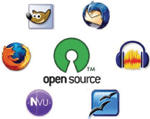
When OSS made its first appearance some 17 years ago, it was seen with an air of suspicion. Some dubbed it a non-starter. But this is not the case today. Linux has gone from strength to strength and now undoubtedly it exerts a great influence on the computing world.
No price is more attractive than free. One of Linux’s most-touted benefits is its initial price. Download the software, install it – and don’t pay anything. But there is more to open-source than just cost savings. It is the performance improvement that matters to most of the users.
Open-Source Software (OSS) has received a significant amount of attention in recent times, thanks to OSS’s perceived benefits in terms of costs, flexibility and security.
At the outset, it is pertinent to note, however, that OSS is never “free”. Though there may not be an initial fee associated with an open-source licence, there are long-term costs associated with support and management. Since OSS products are continually evolving, specialized knowledge is required for ongoing maintenance and support. Specific applications may not find favour over a period of time. This means that developers may move on to newer technologies and may stop supporting old versions of programs. These factors introduce risk into the use of OSS applications. In contrast, while proprietary software has higher initial licensing, software support, and update fees, but support is generally more stable for such products.
Several countries, including China, Bahrain, Costa Rica, the Philippines, Malaysia and South Africa, now have a stated policy preference for OSS. There are some nations such as Argentina, Brazil, Venezuela, Peru and Bulgaria that have gone a step further. The use of OSS has been made mandatory in these countries.
The adoption of Linux is taking place at a rapid pace in India. Linux offers flexibility, ownership and security at little cost. With a variety of returns on investment scenarios for government, business and education, Linux has the potential of accelerating technological innovation as well as economic and social development of the country.
In India, central and state governments are playing a leading role in promoting the use of open-source solutions both in government and industry. Governments are of the belief that training the population in open-source technology and creating a skilled workforce will lead to economic development in the country and the region. Open Source is a growing movement that is gradually picking up steam across India.
With many Linux distribution companies such as Red Hat, Debian, Novell and Mandrake, and an impressive array of IT vendors such as HP, IBM, HCL, Dell and Sun, seconding open-source technologies, end-user organizations now are spoilt for alternatives to proprietary software.
Opponents of open source are of the view that notwithstanding its “free” tag, there are issues with Linux that, in reality, make it more expensive to operate in the long run. Dearth of fully-trained Linux engineers is cited as a significant factor. However, Linux supporters do not concur with this.
Linux is no longer just about software, but knowledge, collaboration. There is not a shadow of doubt that open source is going to occupy a bigger footprint in the lives of people whether they like it or not. It is better to understand it, and avail the benefits it provides. Many vendors are staunch advocates of Linux. IBM and HP provide Linux-based desktop PCs. Adobe Systems, Real Networks, Open Office, Mozilla and Macromedia offer applications running on Linux. Red Hat and Novell have made key product announcements to enhance their Linux offerings on the desktop.
TCO for open-source solutions is an enticing incentive for many firms. However, the advocates of proprietary vendors do not agree to the view. They claim that Linux is not all that cost-effective. But cost savings is not that much of relevance to the customers. What has endeared Linux to the customers is its availability. As the possibility of crashing of Linux does not exist, one need not have to use the Ctrl-Alt-Del keys over and over again.
Linux is more resistant to virus and hacker attacks than other common operating systems.
Linux has an apparent edge over other operating systems in the security realm. It allows the developers to read the code, vet it and consequently correct problems. In March 2005, a version of Linux, Novel’s SuSE Enterprise Server 9, became the first Linux distribution to earn International Common Criteria certification for security level 4.
Open Source gains during Recession
The recession has taken a toll on many technology firms. They are floundering, thanks to the ill-effects of the recession. But these are the hey days for many of the technology companies that offer services tied to open-source software – free programs written by volunteers who collaborate online.
These companies are experiencing double-digit growth. Sales at Red Hat, the world’s biggest independent open-source firm with annual revenues of $653m, grew by 18% year-on-year in the first quarter.
More and more firms are ready to embrace open source. While announcing the results, Jim Whitehurst, President & Chief Executive Officer, Red Hat, said, “Budgets are tight and we think that is good for open source.”
It is, indeed, an established fact that open source has found its wide acceptability. Even traditional software firms are beginning to dabble in it. Some open-source companies have begun to offer proprietary add-ons to open-source programs instead of charging to offer support to organizations using open-source software.
The “free and open-source software” movement, as it is officially called, has come a long way from its anti-establishment origins.
Even as the global economy tanks, open-source companies continue to increase. According to Jeffrey Hammond of Forrester Research, cost is once again the main reason why companies are turning to open source. The success of open source is no longer limited to basic software, such as Linux or Apache, a program that powers web servers.
Open-source firms are making their presence felt in databases (Ingres, for instance), business intelligence (JasperSoft), customer-relationship management and other business applications (SugarCRM, Alfresco). In addition, open-source firms have started to move into new markets without proprietary rivals. For instance, a company called Cloudera distributes a version of Hadoop, a program which helps firms process and analyze the unprecedented volumes of data generated by large websites.
But cost is not the only reason for open source’s increasing popularity. It is now an established fact that open source offers more flexibility than proprietary programs, the licenses for which often include restrictions on how they can be used.
Today, firms no longer perceive free software as riskier. Getting sued for running programs that inadvertently violate somebody else’s intellectual property, for instance, has proven not to be as big an issue as once feared. Most open-source firms indemnify their customers against such lawsuits in any case.
All this has led many companies to develop a much more pragmatic approach to open-source software. In the late 1990s, installing Linux was often something of a gesture of defiance against Microsoft’s domination of the software industry. Today, decisions are more rational. The key question is whether the savings in licensing fees for proprietary products outweigh the additional costs in manpower to integrate and operate the free alternative. “Open-source software has become a means to an end,” says Forrester’s Mr Hammond.
Open-source firms themselves have also become increasingly pragmatic. Red Hat and Novell, its main rival, still make money by giving away Linux and charging for support: customers sign up for a subscription that gives them the right to all the updates and someone to call if something goes wrong. Yet, recent years have seen a flowering of different business models. A popular approach is to sell proprietary extensions to an open-source core.
Conversely, having realized that they can economize on resources and garner good ideas, proprietary software firms are increasingly taking a liking to open-source programs, albeit mostly at the edges of their offerings. IBM has sprinkled open-source software throughout its product line. With the acquisition of Sun Microsystems by Oracle, the database company has now even bigger open-source portfolio including MySQL, a popular program for databases.
Cloud computing, the delivery of processing power over the Internet from vast warehouses of shared machines, has all the potential of blurring the lines between proprietary and open-source software.
Most of the companies offering Cloud computing, such as Google and Amazon, use open-source software, since having to pay licensing fees would make the business unprofitable.
Finally…
In other words, it is a great time to be in the open-source market: a time when enterprises care more about the right functionality at a compelling price than clinging to 20th-century brand names whose idea of CIO value seems to be the software audit.
See What’s Next in Tech With the Fast Forward Newsletter
Tweets From @varindiamag
Nothing to see here - yet
When they Tweet, their Tweets will show up here.





























